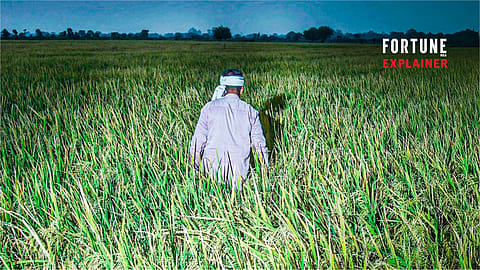Fortune India Explainer: Why there is a debate over Minimum Support Price (MSP) for agriculture crops
Government fixes minimum support prices (MSPs) of 22 mandated agricultural crops (14 kharif crops, 6 rabi crops and 2 other commercial crops) and fair & remunerative price (FRP) for sugarcane on the basis of recommendations of the Commission for Agricultural Costs & Prices (CACP).

Last week, farmer organisation All India Kisan Sabha (AIKS) complained that farmers cultivating 20 major Kharif and Rabi crops could have earned nearly ₹3 lakh crore more in 2024-25 if their produce had been procured at minimum support prices (MSP) determined by the Swaminathan Commission’s recommended formula of C2 + 50%.
The government, on the other hand, says that it has increased MSPs for all mandated Kharif, Rabi and other commercial crops with a minimum return of 50% over all India weighted average cost of production from year 2018-19 onwards. Both are correct in their own ways as they are using different formulas to calculate the MSP.
While farmers have been demanding the adoption of Swaminathan Commission’s formula right from the days of the joint farmer protest organised against the now repealed farm laws some years ago, the government has been persisting that the formula it uses currently to fix MSP is ensuring adequate support to the farmer. Let’s see how the government fixes MSP and what the farmers demand.
How many agriculture crops have government fixed MSP?
Government fixes minimum support prices (MSPs) of 22 mandated agricultural crops (14 kharif crops, 6 rabi crops and 2 other commercial crops) and fair & remunerative price (FRP) for sugarcane on the basis of recommendations of the Commission for Agricultural Costs & Prices (CACP). The crops include paddy, cotton, soybean, maize, groundnut, wheat, gram, arhur (tur), rapeseed, jower, urad, moong, bajra, lentil, ragi, sesamum, barley, sunflower, safflower and nigerseed.
How does Commission for Agricultural Costs & Prices (CACP) arrive at MSP for each crop?
The CACP analyses the following before finalising the MSP for each crop:
Recommended Stories
1. Demand and supply
2. Cost of production
3. Price trends in the market, both domestic and international
4. Inter-crop price parity
5. Terms of trade between agriculture and non-agriculture
6. A minimum of 50% as the margin over cost of production
7. Likely implications of MSP on consumers of that product
The commission then uses the A2+FL formula to recommend MSPs and looks at C2 as benchmark reference costs (opportunity costs) to see if the MSPs recommended by them at least cover these costs in some of the major producing States.
What is A2+FL?
A2 includes cost of inputs such as seeds, fertilizer, labour; A2+FL includes the implied cost of family labour (FL) also.
What is C2?
C2 includes the implied rent on land and interest on capital assets over and above A2+FL.
What is AIKS complaining about?
Let’s take the case of paddy to illustrate the price difference AIKS is point out. While A2+FL is ₹1533 for a quintal paddy, C2 calculation would have brought it to ₹2008. The MSP fixed by the government is ₹2300 while C2+50% would have been ₹3012. Hence AIKS maintains that farmer is losing ₹712 per quintal.